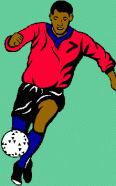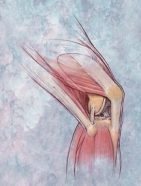Workouts: Does Stretching Help?
Stretching before exercise or sports may not improve performance or reduce the chance of injury.
By Emily Sohn
Touch your toes. Reach for the sky. Twist from side to side.
If you’ve ever played on a sports team or gone to gym class, you probably know the drill. First, you do some warmups. Then you stretch. Exercises and activities follow. At the end of class or practice, you do more stretches.
For decades, coaches and gym teachers have insisted that stretching helps athletes perform better, suffer fewer injuries, and feel less sore the next day. From the health club to the football field to the gymnastics mat, everywhere you look, people stretch.
 |
|
Is stretching before soccer as helpful as just jogging or doing some other sorts of warmups? |
Now, research suggests that stretching may not do your body as much good as people thought. After reviewing more than 350 scientific studies, researchers from the Centers for Disease Control and Prevention (CDC) found that stretching may not reduce the chance of injury.
“There’s insufficient evidence to demonstrate that stretching is effective,” says Stephen Thacker. He’s director of the CDC’s epidemiology program in Atlanta, Ga.
Athletic performance
If it’s athletic performance you’re after, don’t expect stretching to help you run faster, jump higher, or throw a ball farther, either. Some studies show that stretching may actually slow you down, especially if you do it before you play your sport.
To top it off, it now looks as if stretching may actually make you even more likely to get hurt, says Stacy Ingraham.
Ingraham is an exercise physiologist at the University of Minnesota, Twin Cities. Her research focuses on injuries in women and girls, who tend to hurt their muscles and joints more often than men do.
“Certain athletes stretch all the time,” Ingraham says. “They’re the ones who usually get hurt.”
Ingraham points to professional baseball players as an example. They all do stretches before a game, she says. Yet baseball players have one of the highest rates of injury in any sport. Minnesota Twins center fielder Torii Hunter tore his hamstring in his first game of the season.
Ingraham has coached and worked with runners, basketball players, baseball players, and football players. When she persuades them to stop stretching, she says, injury rates tend to go down.
Thacker has noticed a similar pattern. He coaches a high school girl’s basketball team. During his first 5 years of coaching, six girls tore their ACL, a ligament that connects the thigh to the shin and stabilizes the knee. Three years ago, Thacker replaced stretching with specific strengthening exercises and warm-up activities such as jogging and sidestepping. Since then, the team has had no ACL injuries.
Working muscles
To understand why stretching may be a bad idea, it helps to know how muscles work.
It all starts as orders from the brain. Special cells called neurons carry electrical messages from the brain through the nervous system to the muscles you want to activate. If you’re running, your brain tells your legs to move and your arms to pump. As soon as the messages get to their targets, the muscles react. You’re cruising.
 |
|
How muscles are attached to bones at the knee. |
Skeletal muscles are the kind that attach to bones. They do most of the work when you exercise. Skeletal muscles are made up of long, twisted cells called fibers. Proteins inside the fibers help your muscles contract and relax. These muscle movements allow you to run, jump, skip, throw a Frisbee, swim, and more.
With exercise, muscle fibers grow and multiply. The more you work out, the stronger and bigger your muscles get.
When you stretch, you lengthen muscle fibers. It then takes longer for messages from the brain to travel through them. Stretched muscles also seem to be more sluggish than unstretched ones. They don’t spring back as readily. And every time you stretch, you may be tearing your muscle fibers a teeny bit.
Stretching before you exercise is particularly risky, experts say, because stretched muscles are less stable. That makes it harder for them to bounce back from the jarring impact of running, jumping, or weaving around other players on a soccer field.
Instead of stretching before an activity, experts recommend warming up by starting slowly to get blood and oxygen flowing to your muscles. Warming up is also a natural way of stretching your muscles just enough to prepare them for more intense activity.
“If you’re going to play soccer, jog a bit beforehand,” Thacker says. “If you’re going to play baseball, swing the bat before a game.”
Kids don’t get injured as often as adults do because they don’t put the same kind of stresses on their joints, Thacker says. Still, it’s never too early to get into good habits.
Girls, especially, have reason to worry. Among high school athletes, girls are three times more likely than boys to tear the ACL in their knees. By the time they hit the professional level, women tear their ACLs up to 10 times as often as men do, Ingraham says.
Girls hurt their ankles and backs more often than boys, too. Scientists aren’t sure what causes the difference, but girls tend to be more flexible than boys, Ingraham says. Her research suggests that this extra flexibility could be part of the problem. And stretching may only make things worse.
Gentle motions
It may be worth talking about stretching with your coaches and gym teachers.
But if they insist you keep stretching, don’t be too worried, says fitness expert Jay Blahnik. He has written a book called Full-Body Flexibility.
In some cases, gentle stretching can be helpful, Blahnik says, as long as you do the right kind of stretches at the right time and you do them correctly.
Instead of grabbing your ankles and yanking or forcing your body into pretzels, he suggests gentle motions that actively use your muscles.
 |
Try clasping your hands behind your head, Blahnik recommends. Then slowly pull your elbows backward and squeeze your shoulder blades together. “The act of stretching doesn’t decrease injuries,” he says, “but we think being mobile and flexible does.”
As part of a cooldown after a workout, light stretching is also OK, Blahnik says. And, for sports such as gymnastics and dancing, stronger stretching may be appropriate.
Overall, preparation for sports or exercise should involve a variety of activities, not just stretching. Athletes, coaches, trainers, and others need to use the combination of strength training, conditioning, and warming up that’s best for a given sport.
Whatever you decide to do about stretching, don’t stop exercising. Research continues to show that exercise is good for your heart, good for your bones, and good for your muscles. It helps you sleep better and keeps your weight under control. Running around is fun. It can even make you smarter.
Now, stop reading and get a move on!
Word Find: Stretching and Exercise
Going Deeper:







